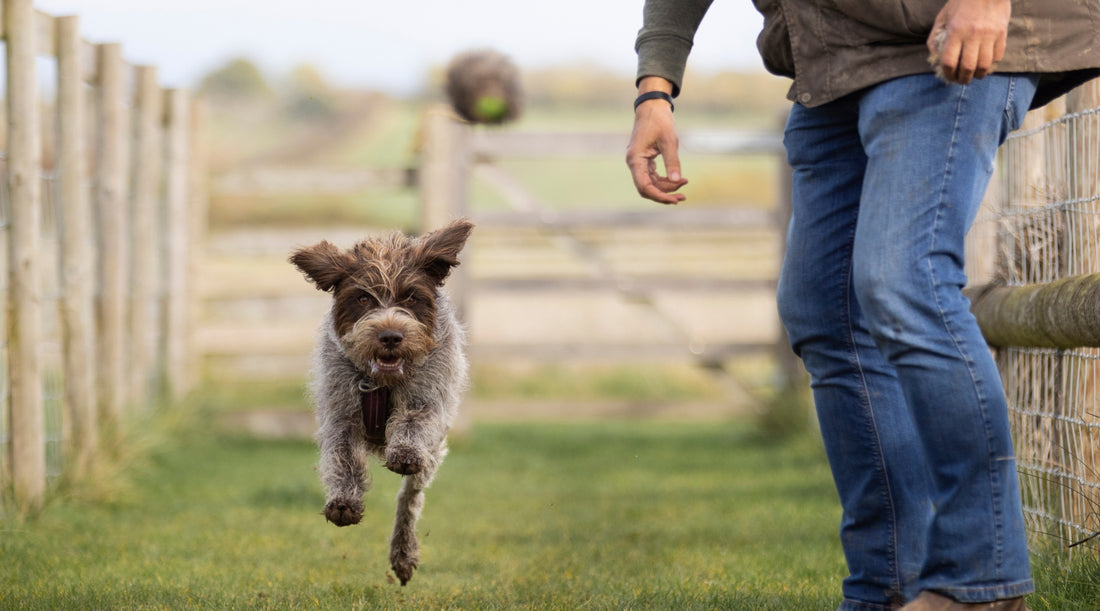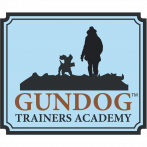
Training with treats: what does your dog find rewarding?
Share
You might have heard the phrase, “what gets rewarded, gets repeated”, but what exactly does your gundog find rewarding, and how can you use this information in your training?
Maybe you’ve heard conflicting advice about using treats, or perhaps you’re unsure whether rewards are really the key to success. Don’t worry, you’re not alone, and you’re in the right place.
This blog isn’t here to debate whether you should use rewards. Instead, we’ll explore the fascinating science behind reinforcement: what it is, how it works, and why it’s so effective. When used thoughtfully, rewards like food, play, and environmental access are incredibly powerful tools for shaping behaviour.
Understanding what motivates your individual gundog is the first step in creating a training programme that’s both effective and enjoyable. In this article, we’ll break down the concept of reinforcers and offer practical insights to help you identify what your dog finds most rewarding. By the end, you’ll have the tools to tailor your approach, ensuring your gundog thrives in training.

The science of training a gundog with rewards
Before we dive into the practicalities of finding the perfect reward for your gundog, let’s clarify an important concept: operant conditioning.
While it is happening less frequently, treats still get condemned by many traditional dog trainers and are often viewed negatively as bribes.
This isn’t a debate about whether or not you should “treat train” your gundog. Used in the correct way, food, environmental, and play rewards all genuinely work and can be incredibly powerful tools when applied properly.
If you’re new to this concept or have been curious about how it really works, let’s briefly explore the science of reinforcement so that you can understand what truly motivates your gundog and how to make specific behaviours more likely to happen again in the future.
You may have heard about the quadrants of operant conditioning. These describe how behaviours are strengthened or weakened based on their consequences. Although learning theory has moved on a long way and many other factors affect learning, we still use the basis of rewarding desirable behaviours to increase the likelihood of them being repeated.
It’s essential to observe the world through your gundog’s eyes, and if you notice a behaviour is becoming stronger (e.g. is being repeated more) in response to a stimulus (e.g. a cue), it’s crucial to identify what reinforcement they’re receiving as it may not always be what you expect.
Our training sessions are always designed to maximise the likelihood of success and reduce the chances of failure in order to build confidence in our dogs and ensure that they enjoy the learning process.
When it comes to choosing the positive reinforcement, this is anything your gundog finds pleasurable.
This could be a tasty treat, a fun ball chase, or a game of tug.
But it could also be the opportunity to keep working, permission to keep hunting, or being sent on the next retrieve. And it might, for some dogs, be verbal praise.
The key is that it’s from your gundog’s perspective. A reward is only a reinforcer if they find it rewarding.
You might have previously had wild success training a dog using verbal praise alone, but if your new puppy does not find you cooing over them rewarding then you might find you’re suddenly struggling.
Now that we understand the science, we can use this information to form the foundation of tailoring rewards to your individual dog. In the next section, we’ll explore how to identify what your dog finds most rewarding and how to use these reinforcers effectively in your training.

How to use food rewards in your gundog training
While it is safe to say the majority of working gundogs will find the innate behaviours of running, hunting, chasing and carrying hugely rewarding, they are challenging for handlers to control and deliver as positive reinforcement.
This is especially true if you are a first-time gundog owner with limited experience of your gundog’s breed-specific traits. Or if you are working with a puppy or young dog who has not yet learnt recall, stop whistle or delivery to hand.
Instead, we can look to the final “consume” part of the hunting chain. Food, a.k.a training treats, is the easiest reinforcement we can deliver in a controlled manner.
Many gundogs, particularly growing and hungry puppies, are very happy to have food reinforcers posted through the ‘front door’ and straight into the mouth.
However, this method alone can limit the power of your food-based reinforcers and can in fact inhibit training over time as if the delivery becomes too predictable it can become boring and less reinforcing.
Whether you are new to training with food, or have been doing it for decades, it is good practice to vary this delivery to add value, thereby keeping your gundog engaged and prolonging the effectiveness of this reinforcement method.
Here are some creative ways to change up your food delivery to keep it fresh and interesting for your gundogs…
Food shop
Prolonged delivery to the mouth while talking to your dog (“wow that was amazing, you were brilliant, here’s another piece and another piece, it was incredible”).
Food scatter
Scatter several pieces of food over a small area and encourage your dog to hunt, help them and be engaged with this.
Ping Pong
Throw a piece of food out for your dog to chase and capture and when they turn back towards you throw another piece in the opposite direction. You can do several repetitions, our dogs love this!
Flick game
Put a large piece of food in the palm of your hand, and when your dog is watching it, flick it for them to chase and capture.
Catch
Throw a piece of food for your dog to catch.
Top tip: Don’t forget to vary the types of food to help keep your dog engaged too. The different shapes, sizes and colours of the food can be used for different delivery methods. For example, a larger piece of cheese for chasing, or small smelly bits for hunting.

How to play with your gundog
Often overlooked, play is an extremely powerful reinforcer for our gundogs.
With gundogs we are always challenged by the lure of the environment. We need to be inventive and thoughtful in order to provide the appropriate type of reinforcement in a given situation.
To elaborate a little, dogs are predators. They love to sniff, stalk, chase, capture and consume. Many also like to dissect or at least tug or rag.
By engaging in play activities that encourage and allow our gundogs to express their natural behaviours, we are tapping into something that is intrinsically rewarding for our dogs.
These games become an increasingly valuable tool when training moves on to more challenging environments which will become evident as we progress our training.
Thinking about this from your gundog’s perspective, an example could be that your gundog is on a walk with you and is suddenly completely absorbed in hunting around a rabbit warren where the scent is really strong.
If you were to ask him to focus back on you and he does and then you offer him a piece of cheese, do you think that piece of cheese would be that valuable to him? He was in hunt mode, not forage or scavenge mode.
What might have been a more powerful reinforcer at that moment would be a game of chasing rabbit skin tennis ball or tug.

Can you ruin a gundog by playing with them?
You might have read or been told that you can’t do certain things with your gundog if you want to take them beating, picking up, or to sit on a peg. The thought of allowing your dog to chase a rabbit skin tennis ball, let alone encouraging them to, might terrify you.
But when done right, playing games with your gundog, including the dreaded chase or tug of war, will not scupper their chances of being a successful working gundog.
You see, all games have rules.
If you take the time to introduce them properly and teach your gundog what you want from them, there should be zero chance of them developing any bad habits which will be translated to the shooting arena.
Body language is the key to playing with your gundog correctly, so your dog knows when it is time to play and when it is time to work.
Your dog will not know the difference between a gundog game and a formal training exercise. But they excel at discriminating between cues and will recognise when you change your body language and go into ‘play mode’, not ‘work mode’.
Your body language while playing should look wildly different from how you behave as a gundog handler to ensure that the distinction is clear for your dog.

How to work out what your gundog wants to play with.
Remembering that a reward is only a reinforcer if your gundog finds it rewarding, we need to work our what our individual gundogs value. Here is a quick recipe to help you get started...
Step one
Scatter a large selection of articles and toys in a close area of your garden or house. The articles can be soft toys, balls, dummies, fur, feather, squeakies, tugs, and kong toys.
Step two
Release your dog into the area and observe what they do. They may check them all out first, try before they buy, change their mind or just target their favourite straight away.
Step three
Observe how your dog plays and interacts with each article. If they bring it to you, you can trade off for food, tuck the toy away and encourage them to find something else.
Step four
This exercise will help you to learn more about your dog and what they like to do and with what articles. Some they may want to retrieve, some they may cache, some they may chew, some they may want to engage with you as well.
Step five
Put away the articles and then bring them out one at a time and play with your dog with the article. Observe what they want to do. Do they want to chase it, tug it, do they want to catch it or do they want you to chase them with it. Their behaviour may be the same on all articles or it may change according to the item itself.
This will give you a 'Hierarchy of Reinforcers' that will be an essential part of your training programme as you work on more challenging exercises in more challenging environments.
Understanding what truly motivates your gundog is just the beginning. At the Gundog Trainers Academy, we delve deeper into these concepts, offering a comprehensive, science-backed training programme that emphasises ethical, non-coercive methods.
Our online membership provides exclusive access to over 30 tutorials, complete with step-by-step instructions, engaging games, and video demonstrations to guide you in training your gundog effectively.
For just £42 per month, you'll receive access to a progressive online training programme with structured tutorials that build upon each other, ensuring a solid foundation for your gundog's training journey. Plus, live quarterly Q&A sessions to ask questions and troubleshoot any challenges you may be facing.
To join the Gundog Trainers Academy Membership today head to: https://gundogtrainersacademy.co.uk/pages/membership
